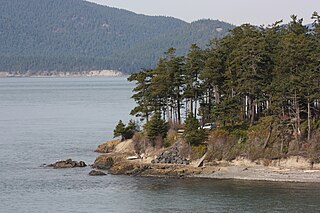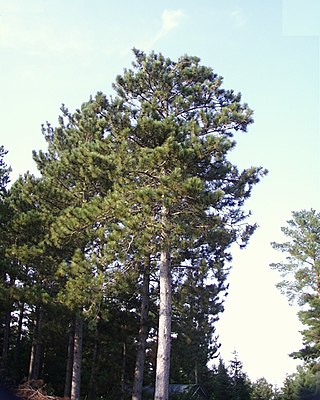
The Douglas fir is an evergreen conifer species in the pine family, Pinaceae. It is native to western North America and is also known as Douglas-fir, Douglas spruce, Oregon pine, and Columbian pine. There are three varieties: coast Douglas-fir, Rocky Mountain Douglas-fir and Mexican Douglas-fir.

The longleaf pine is a pine species native to the Southeastern United States, found along the coastal plain from East Texas to southern Virginia, extending into northern and central Florida. In this area it is also known as "yellow pine" or "long leaf yellow pine", although it is properly just one out of a number of species termed yellow pine. It reaches a height of 30–35 m (98–115 ft) and a diameter of 0.7 m (28 in). In the past, before extensive logging, they reportedly grew to 47 m (154 ft) with a diameter of 1.2 m (47 in). The tree is a cultural symbol of the Southern United States, being the official state tree of Alabama. This particular species is one of the eight pine tree species that falls under the "Pine" designation as the state tree of North Carolina.

Pinus strobus, commonly called the eastern white pine, northern white pine, white pine, Weymouth pine (British), and soft pine is a large pine native to eastern North America. It occurs from Newfoundland, Canada, west through the Great Lakes region to southeastern Manitoba and Minnesota, United States, and south along the Appalachian Mountains and upper Piedmont to northernmost Georgia and perhaps very rarely in some of the higher elevations in northeastern Alabama. It is considered rare in Indiana.

Pinus contorta, with the common names lodgepole pine and shore pine, and also known as twisted pine, and contorta pine, is a common tree in western North America. It is common near the ocean shore and in dry montane forests to the subalpine, but is rare in lowland rain forests. Like all pines, it is an evergreen conifer.

Pinus resinosa, known as red pine, is a pine native to Eastern North America.

Pinus ponderosa, commonly known as the ponderosa pine, bull pine, blackjack pine, western yellow-pine, or filipinus pine, is a very large pine tree species of variable habitat native to mountainous regions of western North America. It is the most widely distributed pine species in North America.

The Sandhills or Carolina Sandhills is a 10-35 mi wide physiographic region within the U.S. Atlantic Coastal Plain province, along the updip (inland) margin of this province in the states of North Carolina, South Carolina, and Georgia. The extent of the Carolina Sandhills is shown in maps of the ecoregions of North Carolina, South Carolina, and Georgia.

The Xyelidae are a comparatively species-poor family of sawflies, comprising about 80 extant species in five genera worldwide, and is the only family in the superfamily Xyeloidea. The fossil record of the family is extensive, comprising more than 120 species and including the oldest fossil Hymenoptera species dating back to the Triassic, between 245 and 208 million years ago. Xyelidae are to be regarded as living fossils since they represent one of the oldest lineages of insects and include still extant forms.

Xyela is a genus of sawflies, belonging to the family Xyelidae.
Xyela alpigena is a species of sawfly in the genus Xyela and is endemic to North America. It can be found from Quebec to Maryland and Maine, and west to Utah and New Mexico. The host plant for the larvae is Pinus strobus.
Xyela bakeri is a species of sawfly in the genus Xyela and is endemic to North America. It can be found from Quebec to Florida, and west to British Columbia and California. It has widespread hosts for its larvae, including Pinus elliottii, P. palustris, P. ponderosa, P. sabiniana, and P. virginiana.
Xyela californica is a species of sawfly in the genus Xyela that is endemic to California.
Xyela cheloma is a species of sawfly in the genus Xyela that is endemic to North America. It can be found in Idaho, Nevada, British Columbia, Washington, and Oregon. The host for the larvae is Pinus ponderosa.
Xyela concava is a species of sawfly in the genus Xyela that is endemic to North America. It can be found in Utah, Nevada, and California. The host for the larvae is Pinus monophylla and P. ponderosa.
Xyela deserti is a species of sawfly in the genus Xyela that is endemic to North America. It can be found in Nevada and California. The host for the larvae is Pinus monophylla.
Xyela dodgei is a species of sawfly in the genus Xyela that is endemic to Florida.
Xyela linsleyi is a species of sawfly in the genus Xyela that is endemic to North America. It can be found in Idaho, British Columbia, Washington, and California. The host for the larvae is Pinus ponderosa.
Xyela lunata is a species of sawfly in the genus Xyela that is endemic to California. The host for the larvae is Pinus coulteri and P. sabiniana.
Xyela minor is a species of sawfly in the genus Xyela that is endemic to North America. It can be found from Quebec to Florida, and west to British Columbia and California. The larvae have widespread hosts, including: Pinus coulteri, P. elliottii, P. muricata, P. palustris, P. ponderosa, P. sabiniana, P. taeda, and P. virginiana.








